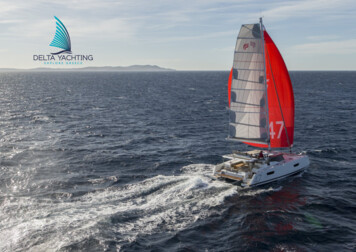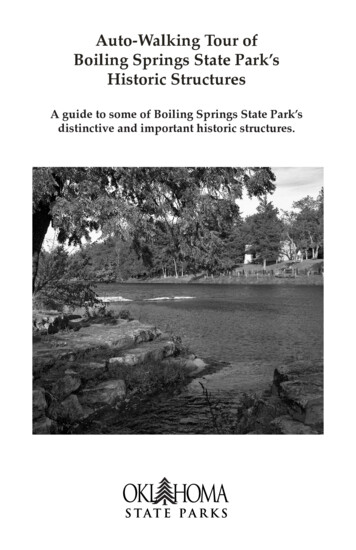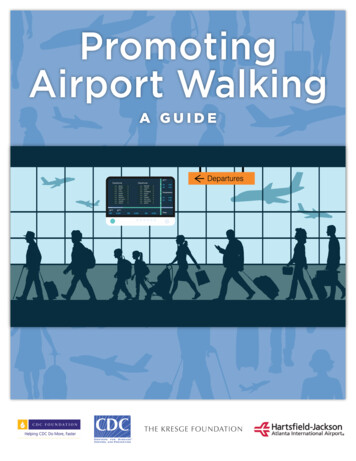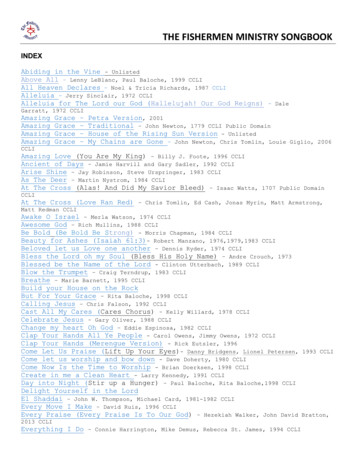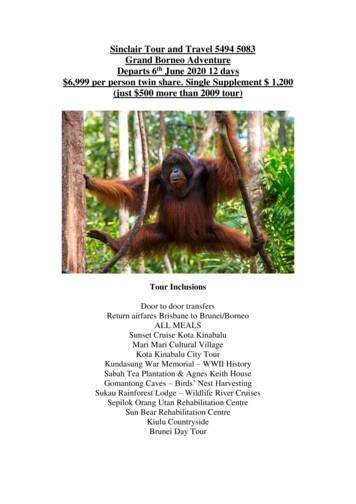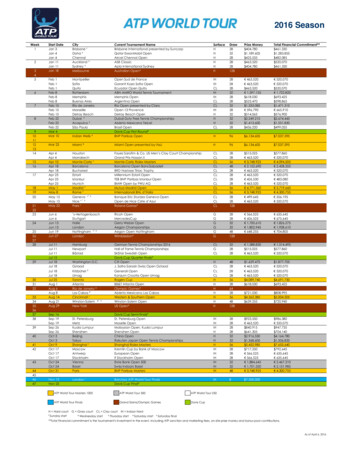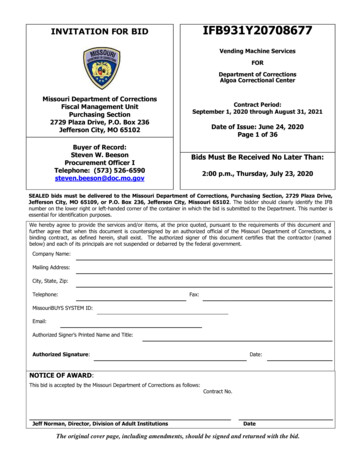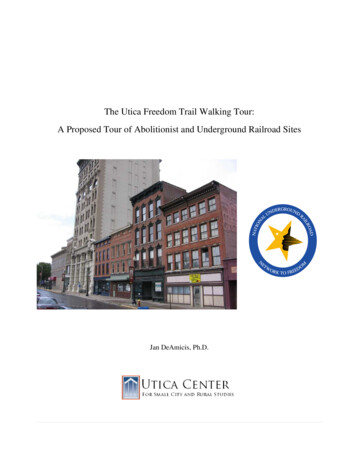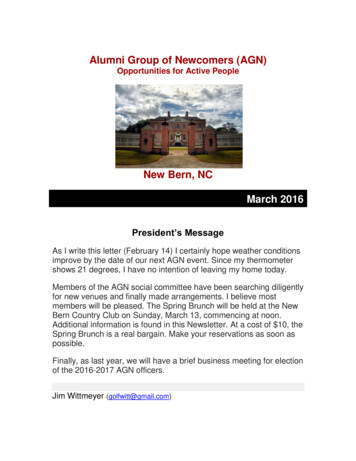
Transcription
Walking Tour of Fishermen’s Terminal. Seattle, Washington
Walking Tour of Fishermen’s Terminal. Seattle, Washington1Dock 3- At the head of dock three is FVO (Fishing Vessel Owners). This is a full service marine ship yard that has been in business at thislocation since 1919. Although you should not go inside of the fence, FVO utilizes a marine way, which is similar to train tracks that runinto the water to pull boats from the water to land so that work can be performed. The small cream colored building closest to the wateris the winch house, which is believed to be the oldest operating building at Fishermen’s Terminal. FVO also leases both sides of theconcrete portion of dock 3 from the Port of Seattle so that work can be performed on boats while they remain in the water.2Dock 3 north- If you walk north on dock 3 past the concrete section, you will come to the wooden fixed portion of the dock. This type ofmoorage is commonly referred to as “Mediterranean Tie” when the stern of the boat is touching the dock and bow of the boat is securedto mooring pile. Although this wooden dock was designed in the 1950’s, the current dock was rebuilt in 2005 in the same mannerbecause it fits the needs of our moorage customers. Most boat owners on this dock appreciate that they have vehicle access directly totheir vessel. The majority of the boats that moor on the wooden portion of dock 3 are longliners and some of the boats on this dock havebeen active fishing boats for 75 years, serving generation after generation of fisherman.3Dock 4- The concrete section of dock 4 is a work area for boats at the terminal. Vessels do not usually more here for more than onemonth at a time while work is being performed on the boat. The wide concrete dock makes access for supply trucks and even cranes toaccess the boats easily to perform required work.4Net sheds 3 and 4, which were built in the 1940’s, are the oldest of the 9 net shed buildings that we have at Fishermen’s Terminal.Buildings 3 and 4 are so tall because when they were built fishing nets were made from cotton and it was necessary for the long nets tobe hung from the ceiling during the off season so that they would dry out. Today most nets are made from synthetic materials and donot need to hang so the lockers have become storage areas that are rented to fishermen to store equipment and other gear needed tooperate the boats.5Net sheds 9, 10, and 11- These net shed buildings are the newest on the Terminal and they were built in the 1990’s. They all featurelightweight metal roll up doors which are still popular today. Net shed 9 is the only two story net shed building and features and electrichoist, called flying forks, that enable loads of up to 2,000 pounds to be lifted to the second floor. If you look up near the peak of the roofyou can see the orange beam that the hoist is attached to.
Walking Tour of Fishermen’s Terminal. Seattle, Washington6Net Pallets-At various locations throughout the Terminal, you will see large wooden pallets, often piled high with fishing net and a tarpsecured to cover the net. Since the invention of synthetic nets, the easiest way to store nets is on these pallets and when the net isneeded the boat and the net are brought to one of the many loading areas at the Terminal where the net can be transferred to onto oroff of the boat or pallet. Nets are very heavy and Fishermen’s Terminal has forklifts with up to 22,000 lb. capacities to move them.Multiple nets of often required for the same boat because of different rules about the length of net or the size of the squares in the netin different fishing areas. The majority of the boats at Fishermen’s Terminal fish in Puget Sound, off the Washington coast, in Bristol Bayand in the Gulf of Alaska so many nets are required.7Net sheds 5, 6, 7 and 8- These net shed buildings were built in the 1960’s to meet the increasing needs of the fishing fleet for locations tostore nets and gear. These buildings have a newer style wooden roll up door, rather than the wooden sliding door that you see on theolder net shed buildings.8The Net Repair Yard is an area of Fishermen’s Terminal that is reserved for fishers to be able to spread their nets out and build or repairthe thousands of knots that make up a fishing net. This area may look like an abandoned parking lot, but it is not. In the pavement, thereare cups where poles can be added as needed so that a net can be hung at a comfortable height for a crew member to perform work onthe net. The yard is divided into 8 lanes that can be reserved by the fishermen for 10 days at a time. Often, before laying a net out on thepavement, the crew will tape a plastic sheet to the ground over the entire lane so that the abrasive pavement will not damage the net.The net is then worked on in 100’ to 200’ sections, and then loaded back on the pallet or directly to the boat. Often the road betweenthe south wall and the net yard is closed to vehicle traffic because there are nets spread out over the roadway. If you see net on theground, please do not drive over it as you can damage the net and your car. The best time of the year to see the net repair yard busy isApril and May when it not unusual to see 30-40 crewmembers working on 8 lanes of nets.9Dock 6 is a floating concrete dock and was one of the last docks to be completely rebuilt during a redevelopment project in 2007. Prior tothis all the docks at the terminal were fixed wooden piers like docks 3 and 4. The floating docks throughout the Terminal are easier forboat owners to use as well as giving owners and deckhands access to the entire side of the vessel. The slips on this dock are all 55’ and65’ long and many midsize fishing boats prefer this dock. On the concrete portion of dock 6, you can see the yellow knuckle boom cranewhich is used by boats to load and offload equipment and gear.
Walking Tour of Fishermen’s Terminal. Seattle, Washington10C-15 Hallway- This hallway is lined with historic pictures of Fishermen’s Terminal ranging from 1914 to 1985. The hallway is also wherethe Fishermen’s Terminal bulletin board is located where you can always see a variety of boats and fishing gear listed for sale. TheFishermen’s Terminal book exchange is also located in the hallway, where customers are welcome to take a book to read free of chargeor leave a book that they have read for someone else to enjoy.11Chinook’s Restaurant is one of four restaurants that are located at Fishermen’s Terminal and is decorated with action pictures of theboats and the fishermen from Fishermen’s Terminal working and catching fish in the waters of Alaska.12Seattle Fishermen’s Memorial was created to remember all of the Seattle area men and women who have lost their lives pursuing theirlivelihood. Names of fishers who were killed in fishing related accidents are listed by the decade on the stone slabs to the right and left ofthe statue. The Seattle Fishermen’s Memorial is overseen by a board of 15 industry volunteers who support the Memorial mission byproviding grief counseling as needed, subsidizing safety training for the fleet and providing college scholarships to the dependents offishers who qualify to be on the Memorial. The statue itself was created by Seattle artist Ron Petty in 1985. Learn more informationabout the Seattle Fishermen’s Memorial at seattlefishermensmemorial.org.13Docks 7 and 8 have 40’, 45’ and 50’ slips and are used by commercial and recreational boats for moorage. All of the slips throughout theterminal have at least 30 and 50 amp power, which is the industry standard at every slip. The 40’ slips are the smallest slips that areavailable at Fishermen’s Terminal. Right next to the south seawall between docks 7 and 8 is a public access float which offers boaters 4hours of free guest moorage if they would like to arrive by boat and use any of the businesses that operate from Fishermen’s Terminal.14Dock 9- is very similar to dock 6, in that it has 55’ and 65’ slips on the east side and it has a yellow knuckle boom crane that boats can useto move fishing gear and equipment, but the west side has 550’ of linear side tie moorage that is for commercial passenger boats o loadand unload passengers. If you ever going on an organized boat ride that is departing from Fishermen’s Terminal, chances are you willmeet the boat at dock 9.15Memorial Garden- The Qingdao Eagle, located west of the terminal building, was erected in commemoration of the 1995 establishmentof a sister-port relationship between Port of Seattle and the Port of Qingdao in China. This park like setting offers visitors the chance to sitand relax and enjoy the terminal.
Walking Tour of Fishermen’s Terminal. Seattle, Washington16West Wall- The west wall of the terminal is host to a variety of activities on boats that moor at Fishermen’s Terminal. In 2007, this areawas made deeper and dredged to a depth of 16’ ensuring that larger boats have access to the west wall. The entire length of the westwall is 700’. 240’ on the south end is reserved and used for off the boat seafood sales. Any fish that is offered has to be sold by the crewand boat that caught the fish. The of the west wall is considered a work area for boats, so boats do not usually moor for extendedperiods of time in this area. The west wall is convenient and useful for boats because service, supply and support vehicles can drive rightup next to the boat. There is also a 3 ton crane and a 3 ton electric hoist that are available for customer use on the west wall. Weldingand other hot work is allowed on the west wall and other designated areas throughout the terminal with the required permits, which areprocured from the Seattle Fire Department.17West Wall Storage- This fenced storage is used by fishing boats throughout the terminal. This area is leased out on a monthly, per squarefoot basis and you will see a variety of equipment from nets to on board processing equipment stored in this area.18Northwest Dock- This is where the biggest boats that moor at Fishermen’s Terminal are located. Most of boats in this area are tied to thedock “stern to” meaning that the rear of the boat is touching the dock and the sides of each boat are tied to each other. Since this iswhere the largest boats at the terminal are located, this is also where the largest electricity is offered with 208v or 480v available to allboats. The bulb on the east end of the northwest dock is reserved for daily moorage, so just like the west wall, boats usually do not moorhere for long and only occupy this space when their work requires that they be side tied to the dock.
What Kind of Fishing Boat is That?Purse SeinerPurse seiners catch salmon andherring by encircling themPurse Seinerwith a long net anddrawing (pursing)the bottom closedto capture the fish.The net is firststacked on the sternof the boat and thenpaid into the waterwhile the boat travels ina large circle around the fish. Thefar end of the net is attached to a power skiff,which helps by holding the net while the seinercompletes the circle. The top of the net stays onthe surface of the water because of its “float line,”which runs through thousands of colorful floats.The bottom of the net falls vertically because of itsweighted “lead line.” As a result, the net hangs likea curtain around the school of fish. The vessel crewthen purses its bottom with a “purse line.” Thelines, and the net, are retrieved through a hydraulicpower block (winch). Once most of the nethas been retrieved, with the remainder ofit lying in a “bag” alongside the vessel, thefish are dipped from the bag and into thevessel’s hold. For large catches of herring,a buying vessel or “tender” comesalongside the fishing vessel and lowersthe end of a fish pump into the baggedpurse seine. The herring are thenpumped aboard the tender and into its holdwithout ever going aboard the seiner. Sometimesreferred to as “limit seiners,” purse seiners aresleek, cabin-forward vessels that are limited byAlaska law to 58 feet. They are recognized by theirlong, clean decks, the boom with its power block,the net stacked on the back, and the power skiffthat is often seen riding “piggyback” aboard thevessel’s stern while it is traveling. Seine-caughtsalmon are delivered “in-the-round” (whole)to buying stations and canneries where theyend up as canned and frozen products.Herring are delivered to processingplants where they are either stripped oftheir roe (eggs), or packaged as bait forother commercial fisheries. Salted herringroe, called “kazunoko,” is shipped to Japanwhere it is a high-priced delicacy.CrabberCrabbers target Dungeness, king, and Tanner crabsusing twine or wire-mesh steel pots (traps). Baitedwith herring or other fresh bait, the pots are left to“soak” for several days. A line extends from eachpot to a surface buoy that marks its location. Thereare several configurations for the pots, though ingeneral, the smaller round pots are fished forDungeness in shallow bays and estuaries, and thelarge, heavy, rectangular potsare fished inwaters deeperthan 100 feetCrabberfor king andTanner crab. Apower winch isused to retrievethe pots. Once aboard,a pot is opened and thecatch sorted. Females andundersized males are released(alive) over the side and legal-sized males areretained in aerated seawater tanks. Crab boatscome in a variety of shapes and sizes, fromaluminum skiffs with outboard motors that fish theinside waters for Dungeness, to seagoing vessels of100 feet or more that ply the Bering Sea and theGulf of Alaska for king crab. Unless one happens tosee a crabber with its decks stacked with pots,identification of a vessel as a crabber might bedifficult for the casual observer. Crabs are deliveredlive to shore stations where they are cooked andthen either canned or sold as a fresh or frozenproduct. A small number are sold live in localmarkets.TrollerTroll vessels catch salmon, principally chinook,coho, and pink salmon, by “trolling” bait orlures through feeding concentrations of fish.The word “troll” comes from a medievalGermanword,“trollen,” andrefers totheTrollerrevolvingmotion of the bait or lures used in this type offishing. Typically, four to six main wire lines arefished, each of which has a large (40lb), lead oriron sinker (“cannon ball”) on its terminal end,and 8 to 12 nylon leaders spaced out along itslength, each of which ends in either a lure orbaited hook. To retrieve hooked fish, the mainlines are wound about small, onboard spoolsvia hand crank (hand trollers) or with hydraulicpower (power trollers), and the fish are gaffedwhen alongside the vessel. The leaders are
What Kind of Fishing Boat is That?then rebaited and let back down. Troll vesselscome in a variety of sizes and configurations,ranging from small hand troll skiffs to large,ocean-going power trollers of 50 feet or morein length. Troll salmon fishermen operatethroughout Southeast Alaska producing a lowvolume, high-quality product. Troll-caughtsalmon are dressed at sea and sold either freshor frozen. Public markets and finerestaurants are the final destination.TrawlerTrawlerTrawlers aresometimesconfusedwith trollers due to theirsimilar sounding names, but there are fewsimilarities. Trawlers typically catch largequantities of midwater species, such as pollockor pink shrimp, and bottomfish, such asflounder, by towing a large, cone-shaped net.Most trawl nets have “doors” on either side ofthe net’s opening to help hold it open, andsome have a heavy chain strung along thebottom of the opening to hold it close to thesea floor. The net is retrieved using hugewinches and a power drum upon which the netis rolled as it is brought aboard. The end of thenet, the “bag” or “cod end,” holds the fish andis usually pulled right up into the back of thevessel on a slanting stern ramp. Trawlers aregenerally large vessels; the largest in the oceanpollock fishery are factory trawlers thatpossess onboard processing facilities. Thesecan be up to 600 feet in length. Catches areoften enormous, yielding up to 100 tons ormore, depending on the fishery, the size of thevessel, and the concentration of fish in thearea. The trawl fishery may process its catchesinto fillets, as in the case of flounder destinedfor the fresh and frozen market, or minced fishcalled “surimi,” which is manufactured intofish sticks and similar products such as artificialking crab. Shrimp fishermen sort their catchesby size and species and sell theproduct as either a whole, frozenproduct, or as a headed, frozenproduct.LonglinerLongliners catch bottomfish (primarily halibut,blackcod, lingcod, and rockfish) via a long linethat is laid on the bottom. Attached areleaders (called gangions) with baited hooks.Each longline can be up to a mile in length andhave thousands of baited hooks. The lines areanchored at each end of each “set.” Lines atthe ends run to the surface and are markedwith a buoy and flag. A longline vessel typicallysets several lines for a 24-hour “soak.” Thelines are retrieved over a side roller with apower winch, and the fish caught, bled ordressed, and then packed in ice in the vessel’shold. Longliners are typically large, 50 feet to100Longlinerfeet inlength,with aweather coveron the stern toprotect the crew. Longlines are coiled andstacked on deck in tubs. Most vessels in thisfishery can pack 20 to 40 tons, or more, of icedproduct. Longliners are identified by theirweather cover and, when not fishing, by thenumerous orange buoys and flags that are tiedalong their rails. This fishery delivers its catchwhole and bled (rockfish), or whole and gutted(halibut), or headed and gutted (blackcod andlingcod) for sale to fresh and frozen markets.GillnetterGillnetters catch salmon, primarily sockeye,chum, and coho, by setting curtain-like netsperpendicular to the direction thefish are traveling as theymigrate along the coast. Thenet has afloat lineon theGillnettertop anda weighted lead line on the bottom. Somefishermen attach an orange buoy ball betweenthe net and the boat, making it easier fortraveling boats to see. The end of the lead lineis attached to a hose ring or engine belt. Thering is generally garden hose and has lead linein it. This prevents the end of the lead linefrom tangling in the mesh and tearing holes inthe net. The mesh is designed to be just largeenough to allow the male fish to get theirheads stuck (gilled) in the mesh. Larger fishand the smaller females are not so readilygilled. Gillnets work best in silty water, whichmakes them difficult for the fish to see.
Walking Tour of Fishermen's Terminal.Seattle, Washington 16 17 18 West Wall- The west wall of the terminal is host to a variety of activities on boats that moor at Fishermen's Terminal.In 2007, this area was made deeper and dredged to a depth of 16' ensuring that larger boats have access to the west wall.
